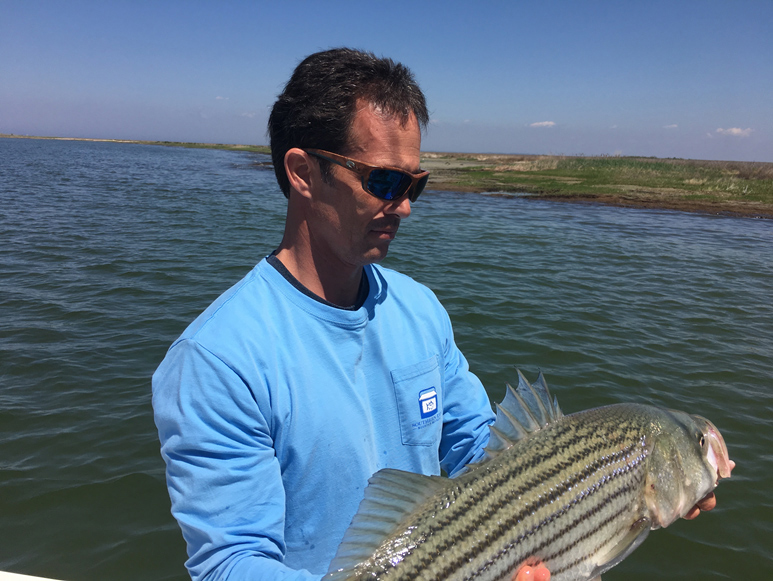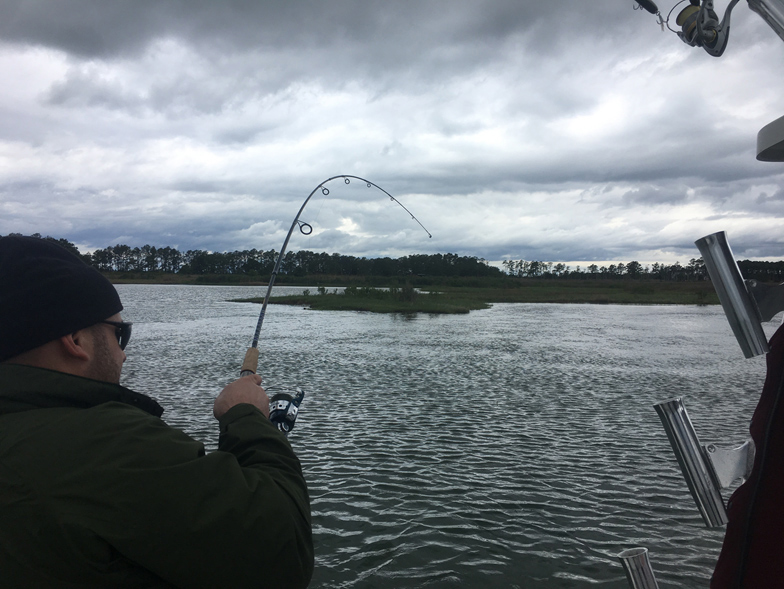The Eastern Shore islands of the Chesapeake Bay offer prime pre-season catch and release fishing for trophy striped bass, and spring is a wonderful time of year to be working the shallow waters of the Chesapeake, as they become alive with fish! Spring fever hits me when the air temperature starts to creep up and the sun rains down that beautiful spring heat – and not only do I get fired up, but so do these shallow water hotspots.

As the Bay water temperature leaves the 40s and rolls into the 50s and 60s the islands of Taylors, Barron, Hoopers, Bloodsworth, Adams, Holland, Spring, and South Marsh begin to fill with baitfish and predators. It’s a shallow water game working around structure such as rocks, points, sod banks, stump fields, and wrecks. Mostly this is happening in less than seven feet of water and sometimes as little as two feet. The calendar doesn’t dictate when this spring right-of-passage occurs; water temperature is the factor that triggers the shallow water striper activity. Baitfish rush into the shallow water being warmed by the sun, and the stripers are right behind them. Keep your eye on our Tangier Sound fishing reports, to get the latest intel on when these areas begin to produce fish.
The prototypical perfect spot can be seen in the picture below. To the left of the point is a large cove with very shallow water. In the spring with sun shining brightly for a day or two, the water temperature in the cove rises quickly compared to open Bay waters. After an incoming tide the cool open Bay water flooding the cove warms by several degrees. As tide changes and begins to roll out, that same water can be up to eight degrees warmer than just outside of the points. In the current ripping around the point is a trough seven-feet deep. We’ve got moving current, warmer water, the structure of the point and a deep near-shore current-scoured trough. This is the perfect recipe for very nice and potentially huge spring-time stripers.

Baits I use in this situation are just a few. The first is a six-inch white, purple glitter, or chartreuse BKD lures on a 3/8 or ½ ounce jighead. I also like the Rapala X-Rap 12, in silver and black or blue and black. Another good one is the four-inch Storm Shad in white or chartreuse. The rod I love in this situation is a six-foot, eight-inch light tackle spinning rod custom-built by Back Yard Custom Rods. I like a rod with some length to make longer casts, sturdy enough to cast a large crankbait, and sensitive enough to detect the subtle strike of a striper while casting a jig.
The key to catching fish is the presentation of the lure and placing it within a reasonable distance from the fish. Here’s what I know: current plus structure equals fish. I like to place the boat within a long cast of the inside edge of the current and far enough off the outside edge of current that we don’t spook the fish. Casting any of the above baits all the way across the current is important in this situation. Fish could be located at the up-current end of the rip, the down-stream end, or anywhere in between. Presenting the lures throughout the rip is important in catching any fish that may be feeding in this area.
Retrieving Fishing Lures for Trophy Bass
The X Rap 12 rattles and vibrates wildly, which draws the predator fish’s attention. If they are there, they’ll detect it from good distance and will hit it hard. Worked very fast, the X Rap 12 will dive about six feet. If the water is shallower than six feet slow down the retrieve a bit and it won’t dive as deep, but remember that an erratic retrieve is key with this bait.
A BKD is thrown across the current; as it hits the water click the bail, and then hold the rod tip up at a 45-degree angle with a snug line in order to detect the “tick” of the jig hitting bottom. Retrieve the jig with short, sharp twitches, while maintaining a taunt line. Stripers, specks or reds will typically hit a BKD as you pause and the lure is dropping back towards the bottom.
The four-inch Storm Shad casts very well, and it’s deadly on shallow water fish. It’s also very easy to use – a lure that even Lenny Rudow could catch a fish on! Cast the Storm Shad across the current. Then click the bail, hold the rod tip low, wait about three seconds while maintaining a snug line, and start turning the reel. Not fast and not really slow, work the bait with a little twitch and erratic speed but much slower than the X Rap 12. Stripers and even a speck or a red may inhale this bait. Cover the entire length of current that wraps around points and off of points.

The beautiful outgoing tidal current rips along the Bloodsworth Island shoreline are big producers of early spring stripers. When fishing stump fields near sod banks I like to position my boat for a fairly long cast from the boat to shore. Landing the bait just off the bank produces well here. Stumps are numerous along many of the eastern shore island shorelines and points. The stumps, coupled with current and near-shore deep water troughs, make for beautiful fish-producing hotspots. Since the thick grass beds haven’t grown yet, it’s the warmer water drawing baitfish in, which draws stripers to these types of areas.
These marshy shorelines become warmed by the sun after a couple of bright days and can be several degrees warmer than the open water of the Chesapeake. Baitfish swarm in, and they’re followed by lots of nice stripers. All shorelines won’t be holding fish, but when they’re found it’s a blast catching and releasing fat frisky Stripers to 32 inches or so. Bigger is possible, but rare.
Over the last four years I’ve spent a lot of time in the eastern shore islands of Maryland in the early spring, running from late March through April. The sheer beauty, remoteness, and spring life full of hungry stripers makes this region a go-to area where you can thoroughly enjoy a beautiful spring day with little to no boat traffic. Good luck to all in 2018 – hope to see you on the water!
Captain Pete Dahlberg runs Four Seasons Guide Service, and follows the fish up and down the Chesapeake Bay. Call 703/395-9955 or visit walleyepete.com, to join him for a day of fishing.
Sign up here to get the weekly FishTalk Chesapeake Bay and Mid-Atlantic fishing reports in your email inbox, every Friday by noon.